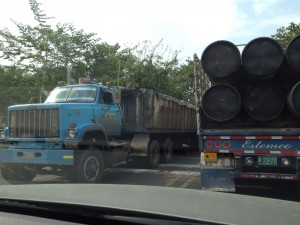World’s Largest Solar Thermal Plant in Saudi Arabia is online
 The plant started working a few days ago after a six-month trial period and build-up. It’s based in Riyadh, Saudi Arabia’s capital and largest city. The facility is almost five football pitches (36.000 m²) big and doubles the size of the former chart-topper in Denmark. With the new solar power plant, it’s now possible to produce enough energy to heat water for 40.000 students at the Princess Noura bint AbdulRahman University, the largest women-only university in the world. The campus consits of 15 academic faculty buildings, various labs and a 700-bed hospital. The $14m plant was manufactured by Austrian research institute GREENoneTEC company and constructed by Jordanian engineering company Millennium Energy Industries. The plant operates via 36,305m2 of solar panels. And based on the lifespan of these panels, the facility could save about 52 million liters of heating oil and 125 million kilograms of CO2.
The plant started working a few days ago after a six-month trial period and build-up. It’s based in Riyadh, Saudi Arabia’s capital and largest city. The facility is almost five football pitches (36.000 m²) big and doubles the size of the former chart-topper in Denmark. With the new solar power plant, it’s now possible to produce enough energy to heat water for 40.000 students at the Princess Noura bint AbdulRahman University, the largest women-only university in the world. The campus consits of 15 academic faculty buildings, various labs and a 700-bed hospital. The $14m plant was manufactured by Austrian research institute GREENoneTEC company and constructed by Jordanian engineering company Millennium Energy Industries. The plant operates via 36,305m2 of solar panels. And based on the lifespan of these panels, the facility could save about 52 million liters of heating oil and 125 million kilograms of CO2.
How did you celebrate Earth Day?
Earth Day was on Sunday, April 22nd, – a day to raise awareness about our planet and the growing threat of climate change. Organizers say more than 1 billion people across the planet took part! Celebrations across the globe marked the day, and the Earth Day Network says it collected more than 1 billion “Acts of Green,” or pledges to help the environment. From exhibitions to concerts to tree planting and cleaning up rivers and roads around the world, the young and old alike pitched in.
What was your act of green?
“The Man Who Planted Trees”

It all started way back in 1979, according to the Times of India . That year, a huge flood washed a lot of snakes ashore on a sandbar. 16-year-old Payeng went there, the day the waters had receded. He found the snakes dead, and that experience changed his live. “The snakes died in the heat, without any tree cover,” he said to the newspaper. When he tried to ask the forest department to plant trees there, he made little headway. Nothing would grow there, the department answered. He should try growing bamboo on the sandbank instead, they told him. So that’s what he did.
Forestry officials in the region first learned of this new forest in 2008. Since then, they’ve come to recognize Payeng’s efforts as truly remarkable. “We’re amazed at Payeng,” says Assistant Conservator of Forests, Gunin Saikia. “Had he been in any other country, he would have been made a hero.”
Fighting climate change together
 It takes a village, goes the saying – and in fighting climate change, many environmentalists say it will take the world. A group of Southern African countries are teaming up to better respond to the challenges of climate change by combining climate studies across the entire region. Angola, Botswana, Namibia, South Africa and Zambia have all agreed to be part of “SASSCAL,” or the Southern African Science Service Centre for Climate Change and Adaptive Land Management. The project is being funded by Germany.
It takes a village, goes the saying – and in fighting climate change, many environmentalists say it will take the world. A group of Southern African countries are teaming up to better respond to the challenges of climate change by combining climate studies across the entire region. Angola, Botswana, Namibia, South Africa and Zambia have all agreed to be part of “SASSCAL,” or the Southern African Science Service Centre for Climate Change and Adaptive Land Management. The project is being funded by Germany.
Because climate change is affecting so many millions of people across Africa, SASSCAL countries want to figure out ways to adapt, to manage the wealth of natural resources in the region. to institute sustainable land management and improve living conditions. That’s no easy job, but with research institutes from every participating country working together to study climate change and its impact on resources, the organizers believe a lot can be achieved. And, it sets an important example for the rest of the continent and the world…
Reporter’s Log: The road of terror
 The road from Santa Marta winds along Colombia’s Pacific coast to Bogotá. It’s one-lane traffic and the path is dotted with potholes. Massive trucks idle in impossibly long lines: tankers, timber trucks and hazardous material transporters all share the same road because it is the only one that takes them to their destination. The landscape along the ride, though, is beautiful: lush, green mountains line the road, carpeted with palm and banana trees as well as ferns. But the idyllic scenery has a darker side, too: here, FARC guerrilla fighters used the thick green canopy to hide kidnapping victims and hold them until they received ransom money in return.
The road from Santa Marta winds along Colombia’s Pacific coast to Bogotá. It’s one-lane traffic and the path is dotted with potholes. Massive trucks idle in impossibly long lines: tankers, timber trucks and hazardous material transporters all share the same road because it is the only one that takes them to their destination. The landscape along the ride, though, is beautiful: lush, green mountains line the road, carpeted with palm and banana trees as well as ferns. But the idyllic scenery has a darker side, too: here, FARC guerrilla fighters used the thick green canopy to hide kidnapping victims and hold them until they received ransom money in return.
![]() read more
read more









Feedback